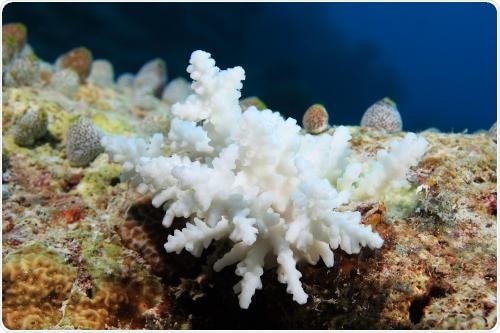A new study by a Stanford University-led research team including Carnegie’s Arthur Grossman and Tingting Xiang unfolds a longstanding puzzle about the connection between the function and form in the genetic material of a complex group of algae known as dinoflagellates.

When the symbiotic relationship between algae and their coral hosts breaks down due to warming oceans and pollution, the coral takes on a ghostly white appearance and is at risk of starvation. Image Credit: Shutterstock.
The study results, which were published in the journal Nature Genetics, could help understand the genomic organizational principles of all species.
Dinoflagellates are a group of over 2,000 species of freshwater and marine plankton, many of which are photosynthetic and some of which eat other organisms for food.
They play a wide range of roles in different ecosystems, including extreme environments, and are primarily known to humans as the cause of poisonous “red tides” and as the origin of most ocean bioluminescence.
A few photosynthetic dinoflagellates are also essential for coral reef health. Individual coral cells absorb these algae and form mutually beneficial relationships in which nutrients are swapped.
Pollution and ocean warming may cause this interaction between animals and alga to break down, leading to ghostly white “bleached” corals that are vulnerable to starvation, potentially causing the extinction of reef habitats.
Like animals and plants, dinoflagellates are complex eukaryotic organisms and are evolutionarily interesting because their genetic material is packaged in a way that is unique among organisms with complex cellular architecture.”
Georgi Marinov, Study Lead Author, Stanford University
One distinguishing feature of eukaryotes is that their DNA is contained within a nucleus within each cell and is organized into distinct units known as chromosomes. In addition, DNA fragments in most eukaryotes are wrapped around a spool-like complex of proteins known as a nucleosome.
It is thought that this organization precedes the shared ancestor of all eukaryotes. It promotes the condensation of genetic material into a small space and regulating access to the DNA as well as how the genes encoded in it are triggered to guide the physiological functions of the cell.
By contrast, even though dinoflagellates are eukaryotes, their genome is not packaged as nucleosomes, but rather appears to be permanently condensed and exist in a liquid crystal state. We still have so much to learn about how genome architecture influences genome function in all eukaryotes; so, dinoflagellate’s exceptional ‘tight’ packaging of DNA may help us understand the similarities and differences in organizational principles among eukaryote genomes.”
Arthur Grossman, Carnegie Institution for Science
To investigate this topic, the research team—which involved Stanford’s Alexandro E. Trevino, Anshul Kundaje, and William J. Greenleaf—used advanced technology to chart the 3D spatial associations of dinoflagellate Breviolum minutum’s genetic material.
Our work revealed topological features in the Breviolum genome that differ from the various models of dinoflagellate genome organization that have been predicted since the 1960s.”
Tingting Xiang, Carnegie Institution for Science
They discovered evidence of massive self-interacting DNA regions named “topologically associating domains” in the dinoflagellate genome. According to the findings, this genomic architecture is caused by the mechanism by which genes are transcribed into RNA, which is then translated into proteins that serve different functions in the cell.
When transcription was blocked, the architecture “loosened up,” meaning that the rigidly maintained topographical features are, in fact, a role of gene activity.
“There are many more questions raised by these results, which represent a big step forward in unraveling the mysteries of the dinoflagellate genome. They are also providing a new perspective on structure-function relationships inherent to chromosomes,” concluded Grossman.
Source:
Journal reference:
Marinov, G. K., et al. (2021) Transcription-dependent domain-scale three-dimensional genome organization in the dinoflagellate Breviolum minutum. Nature Genetics. doi.org/10.1038/s41588-021-00848-5.